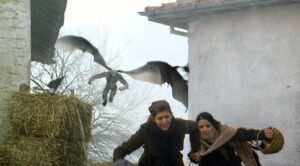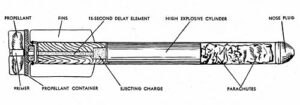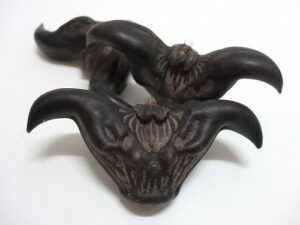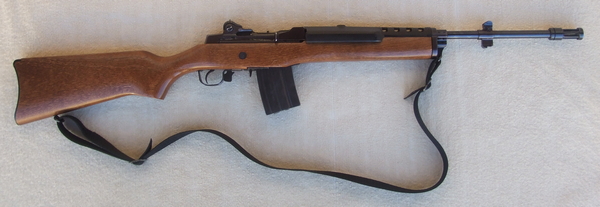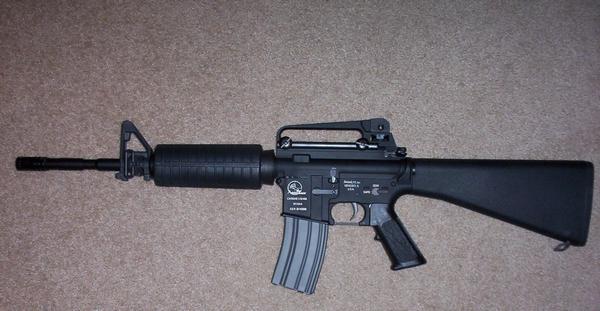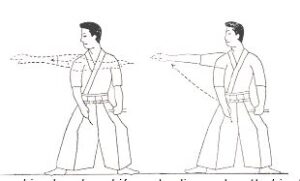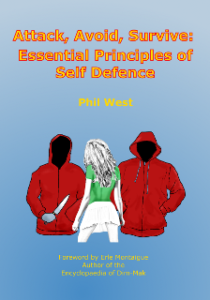I watched the movie “The Challenge” last night. It’s not a bad movie and worth checking out if it appears in your TV listings.
One scene that caught my notice was when the lead character was training with shurikens.
In the background we can see targets, and what struck me was these targets only appeared to have two target areas.
One target was on the chest, on the left side, the other over the groin. A third circle was visible higher up but this may have been an attempt to represent the mouth rather than an aiming point.
The targets are too distant to say for certain, at least on my TV. This hopefully clearer picture from the youtube edition of the movie seems to indicate an aiming point on the throat.

The shurikens used in this movie are cross-shaped four-pointers, about four to five or more inches across. From the way the actors handle them, they evidently have a reasonable weight.
I regard shuriken as being on the borderline of the category of self-defence weapons.
In the movies, including this one, enemies hit by shuriken conveniently fall down dead, perhaps taking a second or so to groan dramatically.
In the real world, shuriken are seldom as effective, even if poisoned.
The unpoisoned shuriken is mainly a weapon of distraction. The use of a shuriken either creates time for you to close distance or to escape. That last statement is also true to throwing knives and many other objects that might be thrown is self-defence.

Having put the shuriken in context, let us think about the targets shown in the movie.
“Left side of the chest” will have many of you thinking of the heart.
It is a common misconception that the heart is on the left side of the chest. It is more accurate to say the heart is more towards the left side, the heart being more central than most people think.
Targeting the left side of the ribs will increase the chances of hitting areas of the heart not covered by the sternum. More importantly it will decrease the possibility of hitting the bony sternum and increase the chances of a point penetrating between the ribs.
Even if it missed the heart, a penetrating wound to the chest will discourage many opponents, particularly if it deflates a lung.
If a shuriken hits a rib it may penetrate the bone (which will be painful), or it may glance off into an intercostal space.
Shaken are multi-pointed and rotating in flight so a point encountering something it cannot penetrate may cause the next point to be flipped into a nearby area.
The shuriken used in the movie were relatively heavy, long, pointed weapons so would be less likely to bounce off a target if thrown correctly than many of the examples that can be purchased over the internet.
Interestingly, in one book I have on shuriken there is a diagram with a target point labelled “Heart” but the line points to two places, one either side of the chest.
The second target area shown was the groin, with the aiming circle over the genitals. A wound to this area is also going to be discouraging, with the victim likely to become more interested in seeking medical attention than fighting.
A near miss above this target will hit the inguinal or lower abdomen area. A miss lower down may hit in the region of the femoral arteries, which will bleed copiously and sometimes fatally if penetrated.
I suspect these practice targets would have had a third target area used, and this would have been the eyes. A shuriken approaching anywhere in the facial region is going to be distracting and the eyes are the obvious aiming point.

Some of you may be wondering about other target areas.
The neck and throat might be a fatal target if hit, and seem to be marked on the movie target but with a weapon like a shuriken hitting this area may be problematic since the chin will often get in the way.
The liver and spleen are less protected by the ribs than the heart/lung target points but may be difficult to target in practice. If you have to aim low the genitals are a better target.
In the movie, a couple of characters are hit in the back by shuriken. One is hit in the back in the rib area (on the left side!), another is hit in the kidney area just under the ribcage.
Many of the upper body targets are protected by bone, making the lower abdomen and thighs better targets if the intention is to wound or deter.
In summary, we have discussed three frontal target areas for light, low-velocity thrown weapons: The eyes, the left lung and the groin.
While hits to these areas can create significant wounds, attacks to these regions also have a good chance of disabling or distracting an aggressor, buying you time to close the distance or escape.
While you may not be carrying a stack of shuriken, many objects you may be holding or that are to hand in your environment can be used instead.
If you can reach it and can throw it, use it if your life is in danger.
In “Shuriken An Illustrated Guide” by Fujita Seiko, the target areas are listed as:
Between the Eyebrows
Both Eyes
The striking point, located below the nose
Near the heart
Area around the nipples
The Solar Plexus
The Armpit
Navel.
Elsewhere in the same book the End of the Nose, Throat, Heart and “Sides” (Liver/Spleen area) are shown as targets.
